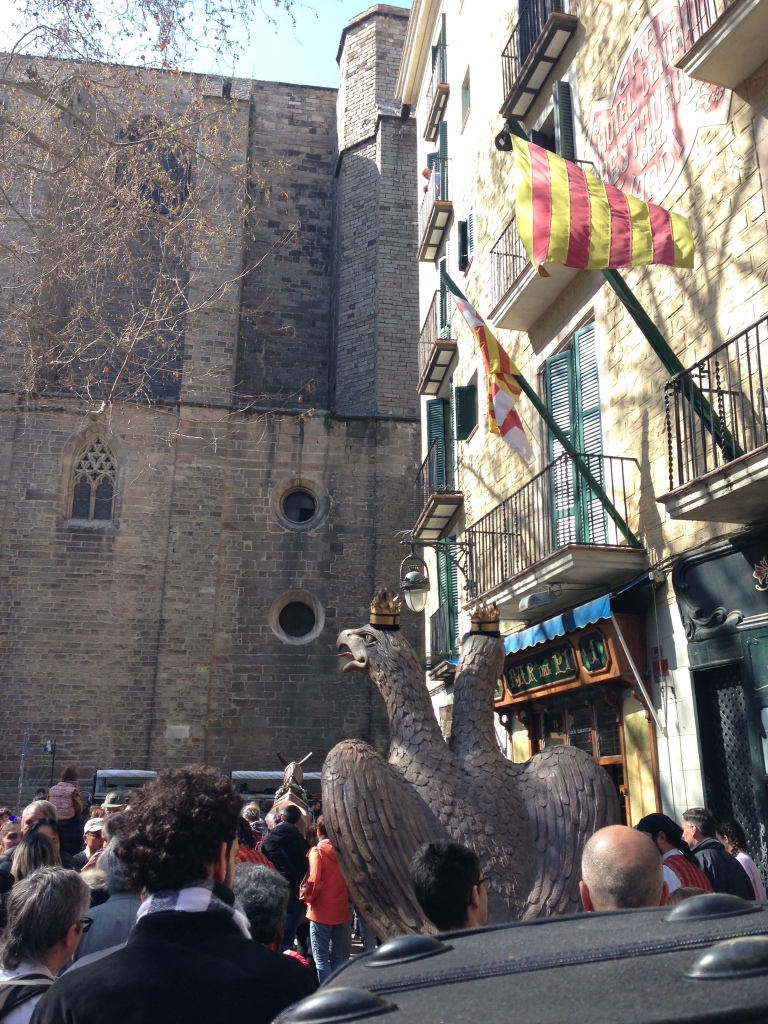
We were looking at the artwork displayed in Placa del Pi, a neighborhood in the old section of Barcelona, when we heard the music.
That distinctive Catalan music with drums and the somewhat shrill sound of grallas, a double-reed woodwind instrument.
We hurried into the narrow streets to join the crowds (this was in pre-pandemic days), as we knew the parade of the Beasts would be arriving soon.

The parade of the Beasts (Bestiari) is part of the Festival of San José Oriol, an annual event held in the Pi community to celebrate their patron saint.
I’d seen the Beasts in La Casa dels Entremesos, the museum in Barcelona that houses the Beasts and many of the Gegants (Giants) that are part of Catalan cultural heritage.
But the Festival of San Jose Oriol was my first time to see the Beasts taking part in an event in Barcelona. (Several days earlier in this multi-day festival, I’d seen the gegants perform and the Castellers build human towers.)
The Lion (El Lleo) led the parade, dancing through the streets, stopping and spinning around to the delight of children and adults.
The Lion had four escorts who walked with it, helping the Lion navigate the crowd and providing a perimeter for the Lion to perform in.
Each Beast had its own team of escorts in color coordinated outfits. Each Beast also had a band that followed it, playing the special song for that particular animal.
The Lion’s team wore maroon vests and pants.

The Mule (La Mulassa), wearing a wreath of flowers, came next, escorted by its team in beige.
Next came the Eagle of Barcelona (L’Àliga de Barcelona) – with two crowned heads. The team wore red and gold striped vests and beige pants.
Finally, the Bull (El Bou) trotted by. Its team wore red shirts, white pants and blue sashes.

The audience was part of this street event, walking along with the Beasts and clapping to the music.
We joined the crowd, walking with the Beasts to Santa Maria de Pi, the community church. The Beasts then participated in a series of performances in the church’s sanctuary.
What a wonderful parade. I decided to do some research online to learn more about the Beasts and the festival.
The Beasts first became part of Catalonia festivals and religious events in the 1400s.
During the 16th and 17th centuries, the Beasts and the Gegants were popular in Catalan festivals.
Each Beast has a religious connection. The Lion represents Saint Matthew. The Eagle represents Saint John. The Ox represents Saint Mark. The Mule is part of the event of the birth of Christ.
The cultural traditions of the Beasts and the religious parades faded when the Catalan culture and language were suppressed after the Spanish Civil War and during Franco’s rule.
The Congrés de Cultura Catalana formed in the 1970s to study Catalan culture. In 1993, a Communal Procession was created based on the history of Catalan festivals. Artists were commissioned to create the historic Beasts.
Then in 1995, the Festes de San Jose Oriol, the festival I attended, was established as an annual event to celebrate the patron saint of the Pi community.
Attending the festival was such a wonderful experience — seeing the parade of Beasts, the parade with the Gegants and the performance of the Castellers.
I appreciate the parade and festival events even more now that I better understand the Catalan culture and history represented.






So enjoyed reading this again!
LikeLiked by 1 person
Cheryl – You were a wonderful tour guide, finding this festival for us to attend.
LikeLike
What a fantastic experience! I love how Catalan culture has developed its own unique and universal identity over the centuries. Thanks for sharing and have a nice day 🙂 Aiva xx
LikeLiked by 1 person
Aiva – Thanks for your comments. So true about how the Catalan culture has developed and survived — and, in some cases, been rediscovered.
LikeLiked by 1 person
This is so informative. I had not heard of this festival.
thanks for sharing your photos too.
LikeLike
Carla – Thanks! I hope you will have the opportunity to attend this festival. The Beasts were one weekend, and the Gegants and castellers were the previous weekend.
LikeLike